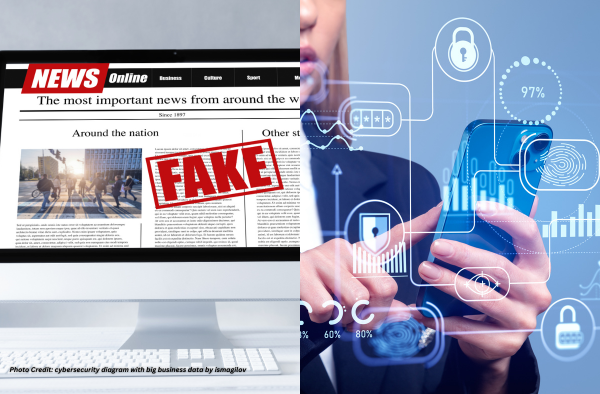Government combats deepfakes with new tech
Share

Artificial intelligence-powered deepfake technology is rapidly evolving, posing significant challenges to government security. This technology can manipulate audio, video, and images to create highly convincing yet ultimately deceptive representations of reality. Using it carries significant risks, such as the spread of disinformation, interference in elections, and the potential for financial fraud.
To address the growing concern and combat deep fakes, governments worldwide are adopting these technologies to strengthen their security measures. Despite the progress made, detecting fakes still faces challenges as these manipulated videos become more sophisticated. However, these challenges also present opportunities for further research and progress in this field. It is essential to continue investing in research to combat deepfakes, as this will give governments a competitive advantage.
Advanced AI and machine learning algorithms
Advanced algorithms are leading the way in the new age of deepfake detection, thanks to the rise of artificial intelligence (AI) and machine learning (ML). These algorithms can accurately detect manipulated content by analysing facial movements, voice patterns, and inconsistencies in digital media. Convolutional neural networks (CNNs) have gained significant attention as an advanced ML technique. These networks can analyse visual data and identify subtle patterns in images that humans might miss. RNNs and LSTM networks are particularly effective at analysing sequential data, which makes them highly suitable for detecting deep fakes in videos.
Various algorithms, including support vector machines (SVMs), K-nearest neighbours (KNN), random forests, and decision trees, detect deepfakes. These algorithms analyse data to determine its authenticity, drawing insights from large collections of real and altered media. Furthermore, state-of-the-art fusion techniques are being employed to enhance the performance of these ML models. An intriguing method involves combining various forms of media, including audio, video, and text, to improve the accuracy of deepfake detection.
Blockchain technology
Blockchain technology is revolutionising digital media authenticity verification. This technology monitors the origin and modifications made to digital files on an immutable ledger, guaranteeing the accuracy of information. This technology operates on a decentralised system, making it highly resistant to tampering. Blockchain technology has a remarkable capability to establish a clear and foolproof method for monitoring the source and alterations of all types of media. DLTs meticulously document each transaction or piece of content, enabling efficient record-keeping.
It is becoming more and more challenging to distinguish between real and fake content in today’s age of AI-generated media. The process becomes even more crucial. The Australian Government is currently investigating the potential of blockchain technology to strengthen electoral processes’ security and address the problem of disinformation. Blockchain technology is becoming increasingly important in establishing trust and reliability in the digital world, as demonstrated by this initiative.
Biometric authentication
Software developers are making strides in biometric authentication technologies, including facial and voice recognition, to tackle the increasing worry surrounding deepfakes. Advanced technologies now enable businesses to analyse unique physical characteristics for identity authentication, providing a robust defence against the increasing risk of identity theft. iProov, a leading company in this field, has developed advanced biometric systems capable of detecting even the most subtle signs of tampering by analysing micro-expressions and other biometric data.
This technology, known as ‘liveness detection’, differentiates between real individuals and artificial representations, effectively countering deep fakes. Furthermore, biometric authentication goes beyond mere facial and voice recognition. To bolster security measures, multimodal biometrics incorporate various biometric authentication methods. This approach effectively identifies anomalies and prevents attempts to hijack accounts using deepfakes. Biometric authentication technologies are proving to be formidable tools in the fight against deepfakes. Integrating these systems can enhance government security protocols, resulting in stronger identity verification processes and a decreased risk of fraud.
Digital watermarking
Advanced technology, known as digital watermarking, effortlessly embeds unique identifiers into media files, making it extremely difficult to make any changes without detection. This technology plays a crucial role in confirming the origin and reliability of digital content. Reputable news sources discreetly incorporate digital watermarks into their audio and video tracks, either during video capture or before distribution. This method for detecting deepfakes is proactive and allows a standalone software application to accurately identify both strong and subtle watermarks.
The European Union recognises the importance of digital watermarking in safeguarding official communications and sensitive information from manipulation. As a result, they are implementing this technology to ensure the security of their data. This development underscores the importance of digital watermarking in the fight against counterfeit products. Digital watermarking, a highly effective tool, protects digital content from manipulation. It is key to counter the dissemination of false information by ensuring the content’s credibility and reliability.
Real-time deepfake detection systems
Government security operations are relying more and more on real-time deepfake detection systems. These systems use artificial intelligence (AI) and machine learning (ML) to analyse video and audio streams in real-time. Receiving prompt notifications when these systems detect deep-fake content is key to protecting critical infrastructure and stopping the spread of harmful material. One system that serves as an example is GOTCHA: Real-Time Video Deepfake Detection via Challenge Response. This system explores the world of talking-head-style video interaction and analyses the challenges that specifically tackle the limitations of real-time deepfake (RTDF) generation pipelines.
The system has shown promising results, with the automated scoring function achieving an impressive 88.6% and 80.1% area under the curve (AUC), respectively. In a remarkable achievement, Intel Labs has developed an advanced platform capable of detecting deep fakes in real-time. The technology focuses on identifying genuine indicators, such as heart rate, rather than searching for signs of deception. This innovative system can distinguish between genuine and artificial personalities using photoplethysmography.
Implementation in government Security
Governments around the world are embracing advanced technologies to strengthen their security measures. The Australian government has set aside a significant $288 million in its 2024 budget to support digital security initiatives. This investment is primarily focused on the implementation of advanced deep-fake detection technologies. This investment underscores the government’s commitment to safeguarding its digital infrastructure and combating the dissemination of false information.
The Singaporean government is making significant efforts to develop artificial intelligence (AI) and machine learning (ML) systems in order to strengthen national security and defend against cyber threats. Identifying and addressing potential cyber threats is essential for safeguarding the integrity and security of the nation’s digital landscape. These technologies play a critical role in this important task. The Biden-Harris Administration, leading the United States government, recently released the National Cybersecurity Strategy Implementation Plan (NCSIP). This plan includes more than 65 federal initiatives that will have a significant impact on cybersecurity.
These initiatives cover a broad spectrum of endeavours, from directly addressing cybercrimes to cultivating a highly skilled cyber workforce that can excel in the modern digital economy. Government security has seen a widespread global adoption of advanced technologies. Governments are taking proactive measures to implement AI and ML systems in order to protect their digital infrastructure, address the growing concern of deepfakes, and strengthen national security.
Deepfake detection technologies play a key role in safeguarding government security in the digital age. Governments are utilising advanced technologies like AI, blockchain, biometric authentication, digital watermarking, and real-time detection systems to combat the dangers of deepfakes and protect the integrity of their operations. The authenticity of digital content is at risk due to the emergence of deepfakes, which illustrates the urgent need to prioritise the development and implementation of detection technologies.
AI and ML technologies have opened up new possibilities for detecting and combating deepfakes. These technologies improve detection accuracy and speed up the process, allowing for timely mitigation of potential threats. In the future, the fight against deep fakes will only grow more intense. Countermeasures must keep pace with the increasing sophistication of deepfake technology. Investing heavily in research and development is crucial for governments to maintain a competitive edge. It is essential that governments, tech companies, and academic institutions work together in order to achieve success in this undertaking.

Justin Lavadia is a content producer and editor at Public Spectrum with a diverse writing background spanning various niches and formats. With a wealth of experience, he brings clarity and concise communication to digital content. His expertise lies in crafting engaging content and delivering impactful narratives that resonate with readers.






Today’s Pick
11th Annual Aus Goverment Data Summit
April 1, 2025
7th Annual NZ Government Data Summit
May 7, 2025
3rd Public Sector Comms Week
May 14, 2025
Subscribe
We send emails,
but we do not spam
Join our mailing list to be on the front lines of healthcare , get exclusive content, and promos.
AI appointment Australia Australian boost boosts business businesses covid-19 cyber cyber attack cyber security cybersecurity data data breach data management defence Digital employment enhance enhances fraud funding governance government grants infrastructure Innovation Lockdown management new zealand NSW NZ online privacy public Public Sector queensland renewable energy scams security Social Media Technology telecommunications victoria
-

Understanding and building your digital strategy
Digital Government, Opinion
-

Featured Leader: Jamie Morse on multi-channel strategies for communication
Communications, Featured Leader
-

Featured Leader: Tegan Tembe of NSW Treasury on creating solid planning strategies and processes
Featured Leader
-

Wirraka Maya Health Service improves patient care with My Health Record
Learning
Show More-

Effects of ineffective communication in the workplace
Communications, Personal Development
-

7 ways you can enhance your personal development skills
News, Personal Development
-

5 advantages of working in the public sector
News, Personal Development, Professional Development
-

7 causes of communication issues in the workplace
Communications, News, Personal Development
Show MoreLast Viewed